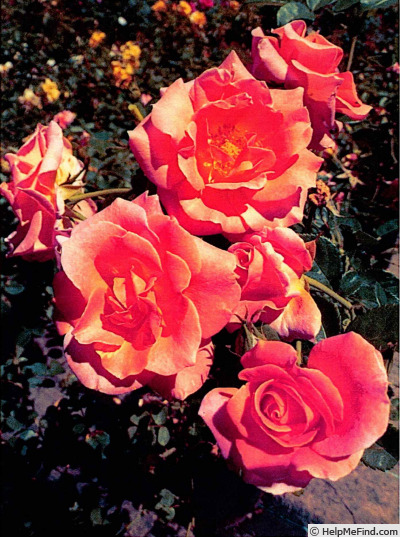|
|
'Brindabella Tuscan' rose Description

Photo courtesy of jedmar
ARS:
Pink blend Hybrid Tea. Registration name: GRAtuscExhibition name: Brindabella Tuscan
Bloom:
Apricot blend to tan. In heat becomes terracotta colour. Mild, sweet fragrance. up to 25 petals. Average diameter 2.75". Medium, double (17-25 petals), cluster-flowered bloom form. Prolific, continuous (perpetual) bloom throughout the season.
Habit:
Medium, arching, compact, upright. Glossy, dark green foliage. 7 leaflets.
Height: 30" to 47" (75 to 120cm). Width: 6¼' to 10' (190 to 305cm).
Growing:
Can be used for beds and borders, container rose, garden or landscape. Very hardy. very vigorous. Disease susceptibility: very disease resistant, very blackspot resistant., very mildew resistant, very rust resistant.
Breeder's notes:
GRAtusc Floribunda. Mild fragrance. Double, (17-25 petals), cluster-flowered, in small clusters, cupped, open bloom form. Prolific, continuous (perpetual) bloom throughout the season. Height of 47" (120 cm). Width of 39" (100 cm). Sylvia E. & John C. Gray (2015)
Patents:
United States - Patent No: PP 31,502 on 3 Mar 2020 VIEW USPTO PATENTApplication No: 16/350,971 on 6 Feb 2019 Inventors: Gray; John Charles (Highfields, AU), Gray; Sylvia Elizabeth (Highfields, AU)
`GRAtusc` is a seedling selection which resulted from the controlled cross-pollination of an unnamed Rosa hybrid female breeding line (not patented) and an unnamed Rosa hybrid male breeding line (not patented). ... After many years of trialing, the female parent was confirmed to possess a combination of desirable traits such as very strong fragrance and having flower color white, borne on a bushy plant growing to 1.2 m tall and wide. The male parent was selected for use in breeding after trialing confirmed the presence of a modern flower color. During the spring of 2013, the female parent was emasculated and was manually pollinated with pollen from the male parent
|